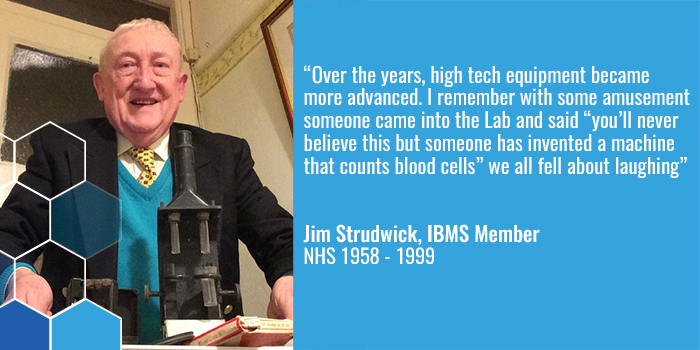Jim Strudwick

Jim joined the IBMS in 1958. Here is his story of working in the NHS.
Apprenticeships
In those long gone days, one did not go to University as such, because in those days of “apprenticeships” one was expected to work-in laboratories-and get your “Uni” type studies part-time and evenings. In my case, as I lived and worked in Chichester Hospitals it was a case of getting the train to Portsmouth and Southampton to study.
I was appointed as a Student Tech (how I hated that description of a learned profession) in 1958, some 60 years ago and all examinations for qualifications both Intermediate and Finals were conducted by the Institute.
In Chichester, there were three hospitals, and therefore three small laboratories. I immediately started my training and studied for the Intermediate Certificate which covered all branches of Pathology and we rotated between all the departments and laboratories.
Laboratory equipment
In those days laboratory equipment was crude and basic, and we invented devices for our tests. For instance, a centrifuge was fashioned from a metal dustbin lid mounted on a central swivel point, with tool clips screwed at intervals around the edge and rotated by a handle and rubber wheel similar to the device that one rolls against the edge of wallpaper.
We counted blood cells and platelets using counting chambers and could count several quite quickly. Haemoglobin was measured by Haldane, diluting the sample in alkaline water with pipettes until the colour matched a graduated standard.
Biochemistry used Folin and Wu tubes boiled in a heated bath to produce the colour for glucose and most other biochemical measurements were by titration and colour changes ( then a Slide-rule calculation. There were Dubosq and Lovibond colour comparators, and the amazing Van Slyke apparatus for measuring Bicarbonate. It goes without saying that all measurements were single tests.
Microbiology then was basic, using blood agar medium on reusable glass Petri dishes, together with MacConkey agar to help identification of microbes, but mainly this was done by eye and smell. There were few antibiotics -Penicillin, Streptomycin, Tetracycline and Chloramphenicol, so a paper antibiotic test strip of PSCT was put onto an agar medium for sensitivities. Amazingly now most Pathogens were sensitive to Penicillin, including Staphylococcus Aureus then.
Tb was grown on Lowenstein-Jensen slopes for six weeks. Histology has changed little except that the stain H&E has moved on to multiple stains now.
Blood grouping was done on a plate using commercial antibodies as was the Coombs test for compatibility. Before the advent of DNA, blood relative matches (eg disputed parentage) were carried out using a batch of antisera available from Welcome to mainly disprove parentage.
After our Intermediate Certificate, we took our extended courses in our chosen specialities over several years. My big interests were haematology, blood group genetics, transfusion science, parasitology and microbiology. I also studied biochemistry. Once we passed this qualification we were thrust into the on-call system. Evening or night, the pay was £1 for every four hours worked and if I was still there in the morning at 9 am, I just had to carry on working for the rest of the day.
Bad enough but it was multi-disciplinary and before they merged, I had to dash between two hospital laboratories and do a whole week on call every four. It was exhausting.
High tech equipment and influencing the future generation
Over the years, high tech equipment became more advanced. I remember with some amusement that someone came into the lab and said “hi chaps, you’ll never believe this but someone has invented a machine that counts blood cells” we fell about laughing, but the rest, as they say, is history. One thing that never changed was the hours spent looking at Blood films or Gram and ZN stains under the microscope.
In 1973, I was “headhunted” to come and take the Senior Biomedical Scientist position at the King Edward V11 Hospital at Midhurst in West Sussex, which was emerging from being a Sanatorium to become a General Hospital with an associated Medical Research Institute.
There I was able to participate in projects such as measuring CO in smokers and Red Cell parameters in Athletes under stress. On my first day, I was invited to look around the Research Institute and was shown the very new computer, which took up a whole room with spools the size of bicycle wheels going round (now the size of a smartphone).
The general laboratory was part of the building. The hospital also encompassed the RAF Chest Unit, where I was able to hone my skills in Parasitology, as the RAF had bases across the world. The Queen was president of the hospital and I met her on two occasions in my laboratory and even showed her a blood film under the microscope. My wife joined the pathology department as a new position of Laboratory Nurse.
When this hospital had to close for financial reasons in 1999, I took my 40 year NHS pension, but moved back to Chichester part-time for another 15 years, until failing eyesight forced me into retirement three years ago, a total of fifty-five years in the National Health Service.
I now confine my medical knowledge to sitting on or chairing various GP advisory committees.
My proudest recent event was when I saw my Grandson presented with his MSc in Biochemistry at Nottingham University. Maybe I influenced him?
